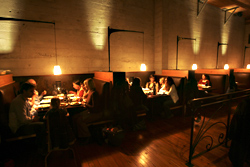They say in the restaurant business that the most important factor for success is location. For me, as a customer, another factor is just as important: scale. If a restaurant’s size, decor, and ambience are out of scale with one another, the diner’s experience is out of focus, too.
So I always feel a chill when I hear that a favorite spot is relocating or upscaling. Case in point: Osteria La Spiga. Certainly, the nine-year-old Italian eatery was not happily located in its hole-in-the-wall quarters on the low-traffic end of Capitol Hill’s Harvard Market. But the minuscule size actually fit La Spiga’s low-key, traditional menu and neighborhood clientele. So how would the spirit of the place survive a transfer to an architect-built, minimalist-chic space four or five times as large?
Well, it turns out. The food, particularly house-made pasta, always deserved better than its jukebox-cafe setting. Surrounded by the trappings of serious dining—rich raw wood, dark steel, airy space—La Spiga’s cuisine gets the showcase it merits.
La Spiga’s continued excellence wasn’t entirely apparent on my first visit. Scaling up a restaurant isn’t just a matter of design; it’s also matter of staffing, and Seattle is a place where it’s much easier to hire a first-rate sous-chef than a first-rate waiter. At the old La Spiga, you always felt your server was the chef’s cousin, or at least deeply cognizant of what constitutes a good plate of pasta. With a few notable exceptions, the waitstaff at the new La Spiga is made up of nice, willing, but largely clueless kids.
Cluelessness is not a problem when a waiter cheerfully acknowledges that he has never heard of Campari, much less tasted it. It definitely is a problem when a waitress firmly asserts that the reason there’s almost no seafood on the menu is that the owners come from the central Italian region of Marche (it’s actually because traditional osterias serve meat or seafood dishes, rarely both); fails to tell a vegetarian that the piedina, or house appetizer bread, is made with meat broth; and demurs when asked for olive oil to dip it in because “that’s not how we do it here.” Isn’t the customer supposed to be always right?
We weren’t altogether crazy about some of the dishes we ordered on that first visit. The menu’s not long—about 10 of each kind of antipasti, pastas, mains, and sides—but it’s fairly intricate, calling for the kind of table-side counsel we didn’t receive. Thin slabs of mild white toma cheese grilled in serpentine marble-green envelopes of grape leaves looked gorgeous, but something was missing; a sprinkle of thyme atop the dish didn’t compensate for its agreeable but bland gooeyness. Butternut-stuffed tortelli (from the first-course menu) also didn’t sing out, despite a dash of sage and Parmesan. Crescione (a sort of two-dimensional calzone made with the house flatbread) was tasty enough, but more like a quick snack than an appetizer.
My vegetarian companion chose to create his own main dish: an order of vegetable fritto misto in a beer batter as delicate as tempura, with a side of grilled polenta for heft. The deep-fried vegetables were delicious, but the polenta arrived long after, and cold to boot. I could sympathize with him, but I was in heaven. My plate of fresh tagliatelle in truffle butter was the kind of dish that confirms Italians’ assertion that pasta dishes are about the pasta, not the dressing. I think the tagliatelli was the best single dish of noodles I’ve ever eaten in the Northwest. However, the entrée that followed—braised boar in a heavy tomato sauce, with only about 10 quarter-inch cubes of roast potato to offset the ragù—was seriously out of balance.
My second visit, with a less officious server and better luck on our choices, was luscious from beginning to end. “Aunt Irene’s eggplant” appetizer—thin tongues of eggplant lightly smeared with a tangy green sauce—stimulated the appetite. Tiny gnocchi in a cream sauce with crumbles of pork sausage and a touch of truffle almost demanded an encore. A generous slab of braised hangar steak was meltingly delicious. A plain patty of grilled sausage with polenta and fontina cheese again showed that simplicity, when perfect, is the best recipe in the world. Sides of grilled endive and roasted Yukon gold potatoes rounded out the meal.
Well, not quite; we also indulged in a serving of the house tiramisù. Not since I first encountered this dish about 40 years ago in San Francisco have I had one as good, the superb sponge cake damp with light syrup, the creamy filling a complement, not a cloying foreground feature.
Four months into operation, the wine program still seems to be finding its feet. Servers were eager to offer what the diner wanted, but no one seemed clear about which wines were available by the glass (any, apparently, if you ask nicely enough). The specialty cocktail lineup is a little faddy, attempting to put an Italianate spin on every item, but execution of standards is impeccable.
Spotty or not, it’s easy to see why the new La Spiga has been packing them in almost since it opened, even on normally slow Mondays and Tuesdays. Its prices are more than fair, its atmosphere alluring, and its food, once you know your way round the menu, terrific. The place already is a Capitol Hill hot spot; when the staff settles in, La Spiga is going to be a citywide magnet for lovers of real Italian eating.
Correction: Although the waiter informed our reviewer otherwise, the piedina is made with olive oil, and owner Pietro Borghesi is from Emilia-Romagna, not Marche.
Jonathan Kauffman is on vacation.








